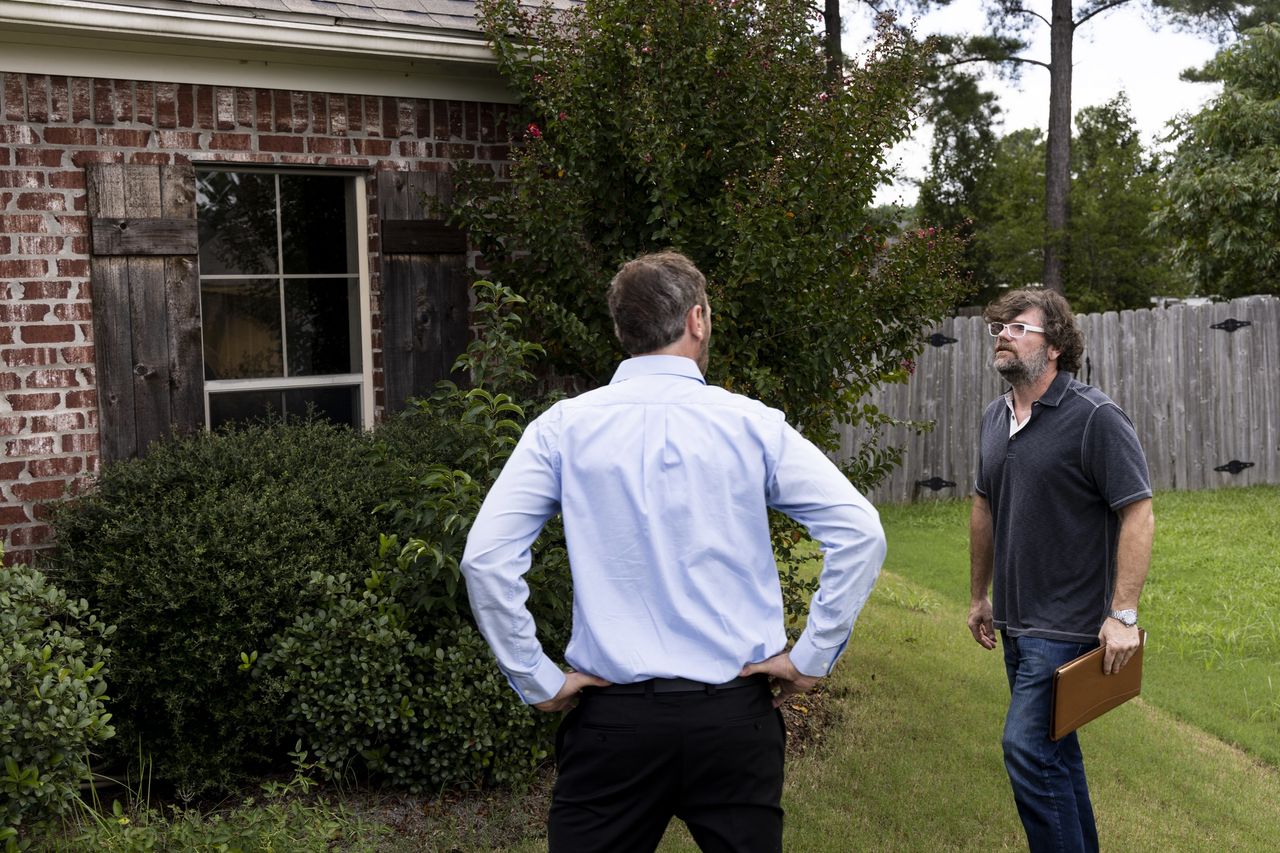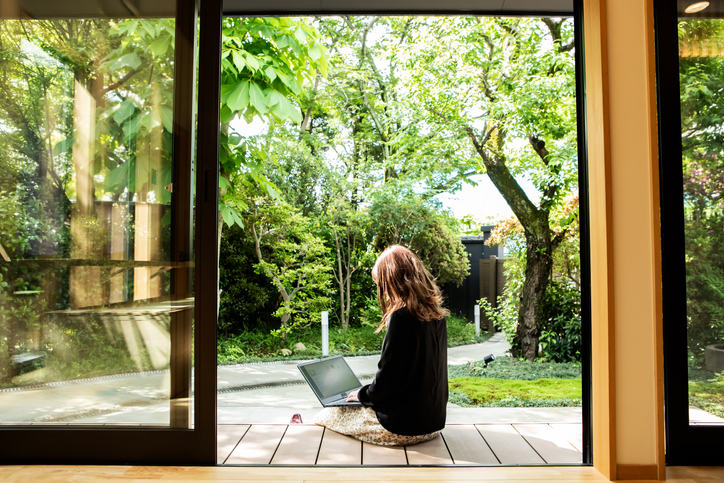Everyone’s a Landlord—Small-Time Investors Snap Up Out-of-State Properties
With the help of recent technologies, laptop landlords are buying homes across the U.S.
Jack Cronin found San Francisco-area homes too expensive or too far from the city centre to buy when he lived there in 2020. The tech worker still wanted a piece of the hottest housing market of his lifetime, so he started looking farther afield.
Last year, the 28-year-old used a website called Roofstock, which provides listings and data for investors interested in rental properties, to buy a three-bedroom home outside Jackson, Miss., for US$265,000. Mr. Cronin, who now lives in New York City, has never visited Jackson nor met the tenants in his home, lightly landscaped with bushes and crepe myrtle trees. It’s enough to know that a management company collects US$2,300 a month in rent for him.
“So far, so good,” he said.
Mr. Cronin is part of a new movement of laptop landlords, in which individual investors are buying homes, often in other states, to rent out. Many are well-paid professionals who view owning a rental as a core investment, alongside stock or bond funds. Recent technologies that simplify the process and enable home purchases online have fueled the movement’s growth.
Data services help would-be landlords pick neighbourhoods with precision, feeding them detailed reports on sales prices, crime rates and local schools. Online real-estate marketplaces such as Roofstock and Appreciate connect them with financing or local managers who can handle property maintenance and leasing. Content publishers and web forums like BiggerPockets offer up investment strategies and tips on where to buy.
“It can all be done online,” said real-estate consultant John Burns in Irvine, Calif. “That’s been the game-changer.”
Home purchases by investors large and small climbed to record levels during the pandemic, reaching a high of 28% of all single-family home sales in February of 2022, up from 17% during the same month in 2019, according to housing data firm CoreLogic. Individuals like Mr. Cronin or other small enterprises that own 10 or fewer homes accounted for about half of all investor purchases.
A separate measure of investor purchases by Attom Data Solutions, prepared for The Wall Street Journal, shows that the niche of out-of-state small investors has also grown. Members of this group, who purchased between two and 10 homes a year, bought 2.1% of all American homes sold in the second quarter of 2022, up from 1.5% during the same quarter in 2019. Purchases of just one house were excluded to rule out vacation homes.
Individual investors had been drawn to the housing market by robust house-price growth, low mortgage rates and rising rents. Home sales have slowed in recent months, the result of higher borrowing costs, limited supply and high prices. Some investors have stepped back from the market, according to real-estate agents and some market reports.
Owning rental property in any market comes with risk. Unforeseen repairs, tenants who stop paying rent and property management fees, often 8% to 10% of revenue, all can eat into potential profit. Some investors who finance their purchases with variable-rate loans may also face higher payments if interest rates continue to climb.
But rents continue to climb to new highs most everywhere in the U.S., making the business potentially lucrative even with rising interest rates.
As a result, even small housing markets are becoming less local. When area residents make offers on homes in Jackson or Jacksonville, Fla., they face nationwide competition from professional real-estate companies and small investors alike, at a time when the inventory of homes for sale is already considered low. That has made it even harder for young locals to start a financial nest egg through homeownership and is compounding rising housing costs.
Melissa Spears and her boyfriend, Michael Kroeze, live in the Jackson area and would like to buy a home together. They started looking last year in the Madison County suburbs, where many of the homes were built this century, have large lawns and are close to good schools and shopping.
Ms. Spears, who works in retail, and Mr. Kroeze, who works at a local bank branch, would like to buy a home priced below $300,000. They have been beaten out of homes by faster offers or all-cash buyers, they said. Ms. Spears said she’s not interested in renting a house as an alternative.
“Renting to us is a complete waste of our money,” she said.
Many of Roofstock’s customers are coastal tech employees making US$200,000 to US$300,000 a year, said Gary Beasley, co-founder and chief executive. These buyers would need some $300,000 in down payments to buy residential property in their own communities. For US$40,000 down, they can buy a house in a lower-cost market and charge rent that brings in steady profits.
“What we’re seeing is people sort of decoupling where they live from where they own,” said Mr. Beasley.
Southern metros with large populations of low- and middle-income renters have been especially popular destinations for coastal investor cash. Out-of-state small investors accounted for 4.24% of total sales in Raleigh, N.C., 5.26% of sales in Atlanta, and 8.61% of sales in Memphis in the first half of this year, according to Attom—much higher than the national average.
Crowdfunding platforms have given small out-of-state investors a way to make fractional purchases in single-family homes as well. One of the newest, Arrived, signed up 12,000 people to invest in 150 rental homes in the past year, with more than 100,000 others applying to make future investments through the company. For one starter home in Clarksville, Tenn., 535 investors contributed to the purchase, some putting in as little as $100.
Investors in lower-cost Southern cities can get higher rents relative to sales prices than in many other places. The Memphis and Birmingham, Ala., metro areas had the highest rents relative to sales price in the U.S. in December 2020, according to an analysis by Roofstock. The monthly mortgage payment for a median-priced home in Birmingham at that time was only US$599, while the median monthly rent was US$1,166, nearly twice as much.
Those kinds of numbers caught Mr. Cronin’s attention, and he initially wanted to invest in Birmingham. He was outbid more than 10 times, some presumably investors like himself, he said.
Jackson has yet to attract as many investors as some other Sunbelt cities, but its cheaper homes have been getting more investor attention recently, which has likely helped boost home values. Across the greater Jackson area, home prices rose 29% between November 2019 and November 2020, according to real-estate brokerage Redfin Corp.
The Mississippi capital still has lower prices than Birmingham, and it boasts a high renter population with attractive rent-to-sales-price ratios. Mr. Cronin said he would only need to increase rent modestly to get his desired annual return of up to 15% over time.
Home prices around Jackson have grown at a slower pace lately than they did in 2020, according to Redfin, which might mean some investors will start shopping in other cities, or even sell their properties to reinvest in markets with stronger price growth. That raises the prospect of more buying opportunities for local home buyers, though it might also inject unwelcome volatility into the market.
Local Jackson real-estate brokers are betting investors will keep coming. Ryan Porter, owner of real-estate agency NextHome Realty Experience, said he’s sold Jackson area rental houses in recent years to investor buyers from California, Nevada, Colorado, Ohio, New York and Washington, D.C. They have looked to cash in on Mississippi’s low home prices, low taxes and unrestrictive rental laws. “They’d rather do it close to them, but they just can’t,” Mr. Porter said.
Evernest, another company that specializes in managing rental properties for out-of-staters, has circulated a white paper touting “landlord-friendly” Mississippi, where there are no limits on how much you can ask a renter to pay for a security deposit and where evictions are faster than in other parts of the country.
Los Angeles software developer Sree Partha bought a three-bedroom house in the Jackson suburb of Brandon for $212,000 in cash last year. He quickly rented it out for $1,855 a month. When his first tenant decided to leave at the end of the lease this spring, Mr. Partha told the local property manager to raise the rent more than 37%, to $2,550.
“When he went out to re-lease, there was much more demand,” Mr. Partha said. He had no problem finding a new tenant.
It hasn’t been all easy money. He bought another house that ended up needing intensive enough repairs that Mr. Partha had to pay to relocate his tenant while the work was done.
City Councilman Aaron Banks, who represents parts of South Jackson, would like to make things harder for out of-state-investors. He’s proposed an ordinance requiring all landlords to register with the city, pay fees and get home inspections in order to operate. His proposal also defines property maintenance standards and would prevent landlords from forcing tenants to open utility accounts through third parties, a practice Mr. Banks said has entailed extra costs for some renters.
Increased investor activity and rising rents have made homeownership less attainable for lower-income people in his district, Mr. Banks said. “It keeps people in a cycle, a repetitive cycle of being a renter all their life,” he said. “You’re paying $1,700 a month, it’s hard for you to probably make payments on time, to get your credit where it needs to be.”
Proponents say investors offer renters access to desirable, safe neighbourhoods in good school districts where they couldn’t afford to buy.
Kevin Ortner, chief executive of rental property manager and online marketplace Appreciate, said that the new wave of small out-of-state investors might cause prices to rise more quickly. But he said that pre-existing affordability problems and a lack of housing supply had already forced people out of the for-sale market, making them more likely to need to rent.
“So long as these people that are out of state…offer a great place for a resident to live, they’re also doing a service for that community,” he said.
Some homeowner associations have grown concerned about an increase in investor purchases in their neighbourhoods and taken steps to restrict them. In Jackson, investors own more than 20% of homes in the Fondren North neighbourhood, according to the homeowner association. Residents are now buying up neighbourhood homes before the out-of-state rental investors can.
Liz Brister, president of neighbourhood preservation group the Fondren Renaissance Foundation, said she has purchased, renovated and sold nine nearby homes to owner-occupiers so far, most of them for under US$200,000.
“We want to bring some first-time homeowners into our community, like we were, 30 years ago,” she said.
Reprinted by permission of The Wall Street Journal, Copyright 2021 Dow Jones & Company. Inc. All Rights Reserved Worldwide. Original date of publication: August 28, 2022.
 Copyright 2020, Dow Jones & Company, Inc. All Rights Reserved Worldwide. LEARN MORE
Copyright 2020, Dow Jones & Company, Inc. All Rights Reserved Worldwide. LEARN MORE
This stylish family home combines a classic palette and finishes with a flexible floorplan
Just 55 minutes from Sydney, make this your creative getaway located in the majestic Hawkesbury region.
Ahead of the Games, a breakdown of the city’s most desirable places to live
PARIS —Paris has long been a byword for luxurious living. The traditional components of the upscale home, from parquet floors to elaborate moldings, have their origins here. Yet settling down in just the right address in this low-rise, high-density city may be the greatest luxury of all.
Tradition reigns supreme in Paris real estate, where certain conditions seem set in stone—the western half of the city, on either side of the Seine, has long been more expensive than the east. But in the fashion world’s capital, parts of the housing market are also subject to shifting fads. In the trendy, hilly northeast, a roving cool factor can send prices in this year’s hip neighborhood rising, while last year’s might seem like a sudden bargain.
This week, with the opening of the Olympic Games and the eyes of the world turned toward Paris, The Wall Street Journal looks at the most expensive and desirable areas in the City of Light.
The Most Expensive Arrondissement: the 6th
Known for historic architecture, elegant apartment houses and bohemian street cred, the 6th Arrondissement is Paris’s answer to Manhattan’s West Village. Like its New York counterpart, the 6th’s starving-artist days are long behind it. But the charm that first wooed notable residents like Gertrude Stein and Jean-Paul Sartre is still largely intact, attracting high-minded tourists and deep-pocketed homeowners who can afford its once-edgy, now serene atmosphere.
Le Breton George V Notaires, a Paris notary with an international clientele, says the 6th consistently holds the title of most expensive arrondissement among Paris’s 20 administrative districts, and 2023 was no exception. Last year, average home prices reached $1,428 a square foot—almost 30% higher than the Paris average of $1,100 a square foot.
According to Meilleurs Agents, the Paris real estate appraisal company, the 6th is also home to three of the city’s five most expensive streets. Rue de Furstemberg, a secluded loop between Boulevard Saint-Germain and the Seine, comes in on top, with average prices of $2,454 a square foot as of March 2024.
For more than two decades, Kyle Branum, a 51-year-old attorney, and Kimberly Branum, a 60-year-old retired CEO, have been regular visitors to Paris, opting for apartment rentals and ultimately an ownership interest in an apartment in the city’s 7th Arrondissement, a sedate Left Bank district known for its discreet atmosphere and plutocratic residents.
“The 7th was the only place we stayed,” says Kimberly, “but we spent most of our time in the 6th.”
In 2022, inspired by the strength of the dollar, the Branums decided to fulfil a longstanding dream of buying in Paris. Working with Paris Property Group, they opted for a 1,465-square-foot, three-bedroom in a building dating to the 17th century on a side street in the 6th Arrondissement. They paid $2.7 million for the unit and then spent just over $1 million on the renovation, working with Franco-American visual artist Monte Laster, who also does interiors.
The couple, who live in Santa Barbara, Calif., plan to spend about three months a year in Paris, hosting children and grandchildren, and cooking after forays to local food markets. Their new kitchen, which includes a French stove from luxury appliance brand Lacanche, is Kimberly’s favourite room, she says.
Another American, investor Ashley Maddox, 49, is also considering relocating.
In 2012, the longtime Paris resident bought a dingy, overstuffed 1,765-square-foot apartment in the 6th and started from scratch. She paid $2.5 million and undertook a gut renovation and building improvements for about $800,000. A centrepiece of the home now is the one-time salon, which was turned into an open-plan kitchen and dining area where Maddox and her three children tend to hang out, American-style. Just outside her door are some of the city’s best-known bakeries and cheesemongers, and she is a short walk from the Jardin du Luxembourg, the Left Bank’s premier green space.
“A lot of the majesty of the city is accessible from here,” she says. “It’s so central, it’s bananas.” Now that two of her children are going away to school, she has listed the four-bedroom apartment with Varenne for $5 million.
The Most Expensive Neighbourhoods: Notre-Dame and Invalides
Garrow Kedigian is moving up in the world of Parisian real estate by heading south of the Seine.
During the pandemic, the Canada-born, New York-based interior designer reassessed his life, he says, and decided “I’m not going to wait any longer to have a pied-à-terre in Paris.”
He originally selected a 1,130-square-foot one-bedroom in the trendy 9th Arrondissement, an up-and-coming Right Bank district just below Montmartre. But he soon realised it was too small for his extended stays, not to mention hosting guests from out of town.
After paying about $1.6 million in 2022 and then investing about $55,000 in new decor, he put the unit up for sale in early 2024 and went house-shopping a second time. He ended up in the Invalides quarter of the 7th Arrondissement in the shadow of one Paris’s signature monuments, the golden-domed Hôtel des Invalides, which dates to the 17th century and is fronted by a grand esplanade.
His new neighbourhood vies for Paris’s most expensive with the Notre-Dame quarter in the 4th Arrondissement, centred on a few islands in the Seine behind its namesake cathedral. According to Le Breton, home prices in the Notre-Dame neighbourhood were $1,818 a square foot in 2023, followed by $1,568 a square foot in Invalides.
After breaking even on his Right Bank one-bedroom, Kedigian paid $2.4 million for his new 1,450-square-foot two-bedroom in a late 19th-century building. It has southern exposures, rounded living-room windows and “gorgeous floors,” he says. Kedigian, who bought the new flat through Junot Fine Properties/Knight Frank, plans to spend up to $435,000 on a renovation that will involve restoring the original 12-foot ceiling height in many of the rooms, as well as rescuing the ceilings’ elaborate stucco detailing. He expects to finish in 2025.
Over in the Notre-Dame neighbourhood, Belles demeures de France/Christie’s recently sold a 2,370-square-foot, four-bedroom home for close to the asking price of about $8.6 million, or about $3,630 a square foot. Listing agent Marie-Hélène Lundgreen says this places the unit near the very top of Paris luxury real estate, where prime homes typically sell between $2,530 and $4,040 a square foot.
The Most Expensive Suburb: Neuilly-sur-Seine
The Boulevard Périphérique, the 22-mile ring road that surrounds Paris and its 20 arrondissements, was once a line in the sand for Parisians, who regarded the French capital’s numerous suburbs as something to drive through on their way to and from vacation. The past few decades have seen waves of gentrification beyond the city’s borders, upgrading humble or industrial districts to the north and east into prime residential areas. And it has turned Neuilly-sur-Seine, just northwest of the city, into a luxury compound of first resort.
In 2023, Neuilly’s average home price of $1,092 a square foot made the leafy, stately community Paris’s most expensive suburb.
Longtime residents, Alain and Michèle Bigio, decided this year is the right time to list their 7,730-square-foot, four-bedroom townhouse on a gated Neuilly street.
The couple, now in their mid 70s, completed the home in 1990, two years after they purchased a small parcel of garden from the owners next door for an undisclosed amount. Having relocated from a white-marble château outside Paris, the couple echoed their previous home by using white- and cream-coloured stone in the new four-story build. The Bigios, who will relocate just back over the border in the 16th Arrondissement, have listed the property with Emile Garcin Propriétés for $14.7 million.
The couple raised two adult children here and undertook upgrades in their empty-nester years—most recently, an indoor pool in the basement and a new elevator.
The cool, pale interiors give way to dark and sardonic images in the former staff’s quarters in the basement where Alain works on his hobby—surreal and satirical paintings, whose risqué content means that his wife prefers they stay downstairs. “I’m not a painter,” he says. “But I paint.”
The Trendiest Arrondissement: the 9th
French interior designer Julie Hamon is theatre royalty. Her grandfather was playwright Jean Anouilh, a giant of 20th-century French literature, and her sister is actress Gwendoline Hamon. The 52-year-old, who divides her time between Paris and the U.K., still remembers when the city’s 9th Arrondissement, where she and her husband bought their 1,885-square-foot duplex in 2017, was a place to have fun rather than put down roots. Now, the 9th is the place to do both.
The 9th, a largely 19th-century district, is Paris at its most urban. But what it lacks in parks and other green spaces, it makes up with nightlife and a bustling street life. Among Paris’s gentrifying districts, which have been transformed since 2000 from near-slums to the brink of luxury, the 9th has emerged as the clear winner. According to Le Breton, average 2023 home prices here were $1,062 a square foot, while its nearest competitors for the cool crown, the 10th and the 11th, have yet to break $1,011 a square foot.
A co-principal in the Bobo Design Studio, Hamon—whose gut renovation includes a dramatic skylight, a home cinema and air conditioning—still seems surprised at how far her arrondissement has come. “The 9th used to be well known for all the theatres, nightclubs and strip clubs,” she says. “But it was never a place where you wanted to live—now it’s the place to be.”
With their youngest child about to go to college, she and her husband, 52-year-old entrepreneur Guillaume Clignet, decided to list their Paris home for $3.45 million and live in London full-time. Propriétés Parisiennes/Sotheby’s is handling the listing, which has just gone into contract after about six months on the market.
The 9th’s music venues were a draw for 44-year-old American musician and piano dealer, Ronen Segev, who divides his time between Miami and a 1,725-square-foot, two-bedroom in the lower reaches of the arrondissement. Aided by Paris Property Group, Segev purchased the apartment at auction during the pandemic, sight unseen, for $1.69 million. He spent $270,000 on a renovation, knocking down a wall to make a larger salon suitable for home concerts.
During the Olympics, Segev is renting out the space for about $22,850 a week to attendees of the Games. Otherwise, he prefers longer-term sublets to visiting musicians for $32,700 a month.
Most Exclusive Address: Avenue Junot
Hidden in the hilly expanses of the 18th Arrondissement lies a legendary street that, for those in the know, is the city’s most exclusive address. Avenue Junot, a bucolic tree-lined lane, is a fairy-tale version of the city, separate from the gritty bustle that surrounds it.
Homes here rarely come up for sale, and, when they do, they tend to be off-market, or sold before they can be listed. Martine Kuperfis—whose Paris-based Junot Group real-estate company is named for the street—says the most expensive units here are penthouses with views over the whole of the city.
In 2021, her agency sold a 3,230-square-foot triplex apartment, with a 1,400-square-foot terrace, for $8.5 million. At about $2,630 a square foot, that is three times the current average price in the whole of the 18th.
Among its current Junot listings is a 1930s 1,220-square-foot townhouse on the avenue’s cobblestone extension, with an asking price of $2.8 million.
This stylish family home combines a classic palette and finishes with a flexible floorplan
Just 55 minutes from Sydney, make this your creative getaway located in the majestic Hawkesbury region.






















